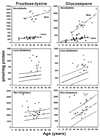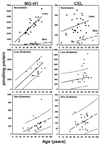Anaerobic vs aerobic pathways of carbonyl and oxidant stress in human lens and skin during aging and in diabetes: A comparative analysis
- PMID: 20541005
- PMCID: PMC2910832
- DOI: 10.1016/j.freeradbiomed.2010.06.003
Anaerobic vs aerobic pathways of carbonyl and oxidant stress in human lens and skin during aging and in diabetes: A comparative analysis
Abstract
The effects of anaerobic (lens) vs aerobic (skin) environment on carbonyl and oxidant stress are compared using de novo and existing data on advanced glycation and oxidation products in human crystallins and collagen. Almost all modifications increase with age. Methylglyoxal hydroimidazolones, carboxymethyllysine, and carboxyethyllysine are severalfold higher in lens than in skin and markedly increase upon incubation of lens crystallins with 5mM ascorbic acid. In contrast, fructose-lysine, glucosepane crosslinks, glyoxal hydroimidazolones, metal-catalyzed oxidation (allysine), and H(2)O(2)-dependent modifications (2-aminoapidic acid and methionine sulfoxide) are markedly elevated in skin, but relatively suppressed in the aging lens. In both tissues ornithine is the dominant modification, implicating arginine residues as the principal target of the Maillard reaction in vivo. Diabetes (here mostly type 2 studied) increases significantly fructose-lysine and glucosepane in both tissues (P<0.001) but has surprisingly little effect on the absolute level of most other advanced glycation end products. However, diabetes strengthens the Spearman correlation coefficients for age-related accumulation of hydrogen peroxide-mediated modifications in the lens. Overall, the data suggest that oxoaldehyde stress involving methylglyoxal from either glucose or ascorbate is predominant in the aging noncataractous lens, whereas aging skin collagen undergoes combined attack by nonoxidative glucose-mediated modifications, as well as those from metal-catalyzed oxidation and H(2)O(2).
Copyright 2010 Elsevier Inc. All rights reserved.
Figures







Similar articles
-
Mechanism of lysine oxidation in human lens crystallins during aging and in diabetes.J Biol Chem. 2009 Dec 11;284(50):34618-27. doi: 10.1074/jbc.M109.032094. Epub 2009 Oct 23. J Biol Chem. 2009. PMID: 19854833 Free PMC article.
-
Topical application of L-arginine blocks advanced glycation by ascorbic acid in the lens of hSVCT2 transgenic mice.Mol Vis. 2011;17:2221-7. Epub 2011 Aug 18. Mol Vis. 2011. PMID: 21897744 Free PMC article.
-
Methylglyoxal-derived hydroimidazolone advanced glycation end-products of human lens proteins.Invest Ophthalmol Vis Sci. 2003 Dec;44(12):5287-92. doi: 10.1167/iovs.03-0573. Invest Ophthalmol Vis Sci. 2003. PMID: 14638728
-
Dietary glycation compounds - implications for human health.Crit Rev Toxicol. 2024 Sep;54(8):485-617. doi: 10.1080/10408444.2024.2362985. Epub 2024 Aug 16. Crit Rev Toxicol. 2024. PMID: 39150724
-
The Role of Glyoxalase in Glycation and Carbonyl Stress Induced Metabolic Disorders.Curr Protein Pept Sci. 2020;21(9):846-859. doi: 10.2174/1389203721666200505101734. Curr Protein Pept Sci. 2020. PMID: 32368974 Review.
Cited by
-
The molecular basis of memory. Part 2: chemistry of the tripartite mechanism.ACS Chem Neurosci. 2013 Jun 19;4(6):983-93. doi: 10.1021/cn300237r. Epub 2013 Mar 21. ACS Chem Neurosci. 2013. PMID: 23419130 Free PMC article. Review.
-
Decreased methylglyoxal-mediated protein glycation in the healthy aging mouse model of ectopic expression of UCP1 in skeletal muscle.Redox Biol. 2023 Feb;59:102574. doi: 10.1016/j.redox.2022.102574. Epub 2022 Dec 6. Redox Biol. 2023. PMID: 36521306 Free PMC article.
-
Collagen Biosynthesis, Processing, and Maturation in Lung Ageing.Front Med (Lausanne). 2021 May 20;8:593874. doi: 10.3389/fmed.2021.593874. eCollection 2021. Front Med (Lausanne). 2021. PMID: 34095157 Free PMC article. Review.
-
The LEGSKO mouse: a mouse model of age-related nuclear cataract based on genetic suppression of lens glutathione synthesis.PLoS One. 2012;7(11):e50832. doi: 10.1371/journal.pone.0050832. Epub 2012 Nov 30. PLoS One. 2012. PMID: 23226398 Free PMC article.
-
The association between skin collagen glucosepane and past progression of microvascular and neuropathic complications in type 1 diabetes.J Diabetes Complications. 2013 Mar-Apr;27(2):141-9. doi: 10.1016/j.jdiacomp.2012.10.004. Epub 2012 Nov 12. J Diabetes Complications. 2013. PMID: 23153673 Free PMC article. Clinical Trial.
References
-
- Monnier VM, Mustata GT, Biemel KL, Reihl O, Lederer MO, Zhenyu D, Sell DR. Cross-linking of the extracellular matrix by the maillard reaction in aging and diabetes: an update on "a puzzle nearing resolution". Ann N Y Acad Sci. 2005;1043:533–544. - PubMed
-
- Lee KW, Mossine V, Ortwerth BJ. The relative ability of glucose and ascorbate to glycate and crosslink lens proteins in vitro. Exp Eye Res. 1998;67:95–104. - PubMed
-
- Saxena P, Saxena AK, Cui XL, Obrenovich M, Gudipaty K, Monnier VM. Transition metal-catalyzed oxidation of ascorbate in human cataract extracts: possible role of advanced glycation end products. Invest Ophthalmol Vis Sci. 2000;41:1473–1481. - PubMed
-
- Tarsio JF, Wigness B, Rhode TD, Rupp WM, Buchwald H, Furcht LT. Nonenzymatic glycation of fibronectin and alterations in the molecular association of cell matrix and basement membrane components in diabetes mellitus. Diabetes. 1985;34:477–484. - PubMed
-
- Sakata N, Meng J, Takebayashi S. Effects of advanced glycation end products on the proliferation and fibronectin production of smooth muscle cells. J Atheroscler Thromb. 2000;7:169–176. - PubMed
Publication types
MeSH terms
Substances
Grants and funding
LinkOut - more resources
Full Text Sources
Other Literature Sources
Medical

